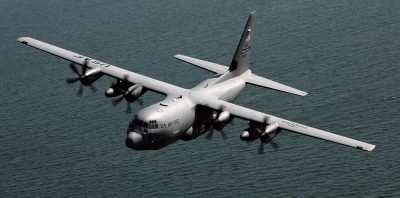Wed, May 13, 2015
Six Sorties Conducted Into The Subtropical System
Aircrews from the 53rd Weather Reconnaissance Squadron "Hurricane Hunters" flew their WC-130J Hercules off the southeast coast of the U.S. in support of the first storm mission of the 2015 hurricane season, Tropical Storm Ana.

Ana made landfall early May 11 near Myrtle Beach, South Carolina, with maximum sustained winds of 45 mph, and was downgraded to a tropical depression later in the day as it moved inland.
The Hurricane Hunters began looking for circulation patterns in the wind fields while flying low-level investigations into the storm over the Caribbean May 7. The system began working its way toward the Eastern Seaboard of the U.S. that night when it was named Subtropical Storm Ana. It officially became a tropical storm early in the morning of May 9.
The Hurricane Hunters flew a total of six sorties into the storm, averaging about seven to eight hours per mission.
Even though this particular storm took place before the official start of the hurricane season, which normally lasts from June 1-Nov. 30, it is not unheard of for a storm to form before June 1, said Maj. Douglas Gautrau, a 53rd WRS aerial reconnaissance weather officer.
"There have been tropical storms every month of the year throughout history," Gautrau said. "But we're (always) prepped and ready to get into the game."
Lt. Col. Jon Talbot, the 53rd WRS aerial reconnaissance weather chief, said aircrews release dropsondes from the aircraft into the storms to gather weather data such as current pressure, temperature, humidity, wind speed and direction.
Talbot said the Hurricane Hunters receive their storm taskings for collecting weather data from the National Hurricane Center and are "ready to go whenever the call comes in."
The storm data gathered is sent every 10 minutes to the National Hurricane Center to increase accuracy of their storm tracking models.
While Ana was brewing in the Atlantic, other members of the Hurricane Hunter’s squadron were also participating in a week-long Hurricane Awareness Tour along the east coast of the U.S. One of the stops the Hurricane Hunters visited was Myrtle Beach International Airport on May 6, which was close to where Ana made landfall a few days later.
Randall Webster, the director of Horry County Emergency Management, commented on the teamwork involved in gathering and distributing information to the public for situations like tropical storms and hurricanes. He expressed his appreciation for the data collected by the Hurricane Hunters.
"We recognize the value of having the Hurricane Hunters in that storm gathering data for the forecast we got, and that led us to get a better understanding of the strength and path of the storm," Webster said. "This allowed us not to over-respond or put out more of an expense then what was necessary to prepare for it."
(Image from file)
ANN Salutes Tech. Sgt. Ryan Labadens, 403rd Wing Public Affairs
More News
The Industry Continues to be Rocked By Some Questionable Operations Recent investigations and a great deal of data has resulted in ANN’s SportPlane Resource Guide’s rep>[...]
Make Sure You NEVER Miss A New Story From Aero-News Network Do you ever feel like you never see posts from a certain person or page on Facebook or Instagram? Here’s how you c>[...]
Visual Approach Slope Indicator (VASI) An airport lighting facility providing vertical visual approach slope guidance to aircraft during approach to landing by radiating a directio>[...]
Airport Marking Aids Markings used on runway and taxiway surfaces to identify a specific runway, a runway threshold, a centerline, a hold line, etc. A runway should be marked in ac>[...]
Aero Linx: The Skyhawk Association The Skyhawk Association is a non-profit organization founded by former Skyhawk Pilots which is open to anyone with an affinity for the A-4 Skyhaw>[...]
 Unfortunate... ANN/SportPlane Resource Guide Adds To Cautionary Advisories
Unfortunate... ANN/SportPlane Resource Guide Adds To Cautionary Advisories ANN FAQ: Turn On Post Notifications
ANN FAQ: Turn On Post Notifications ANN's Daily Aero-Term (04.29.24): Visual Approach Slope Indicator (VASI)
ANN's Daily Aero-Term (04.29.24): Visual Approach Slope Indicator (VASI) ANN's Daily Aero-Term (04.28.24): Airport Marking Aids
ANN's Daily Aero-Term (04.28.24): Airport Marking Aids ANN's Daily Aero-Linx (04.28.24)
ANN's Daily Aero-Linx (04.28.24)



